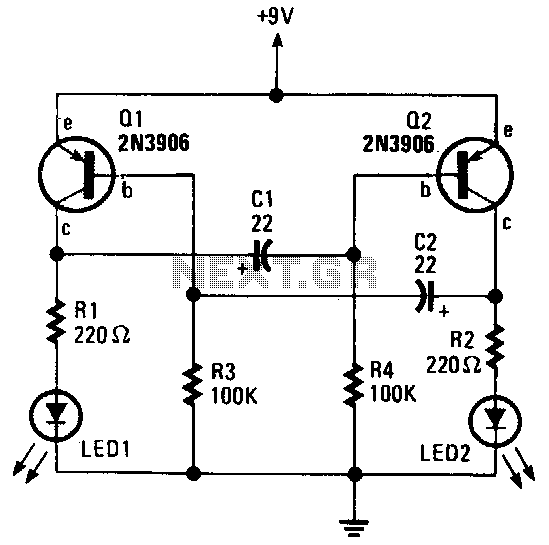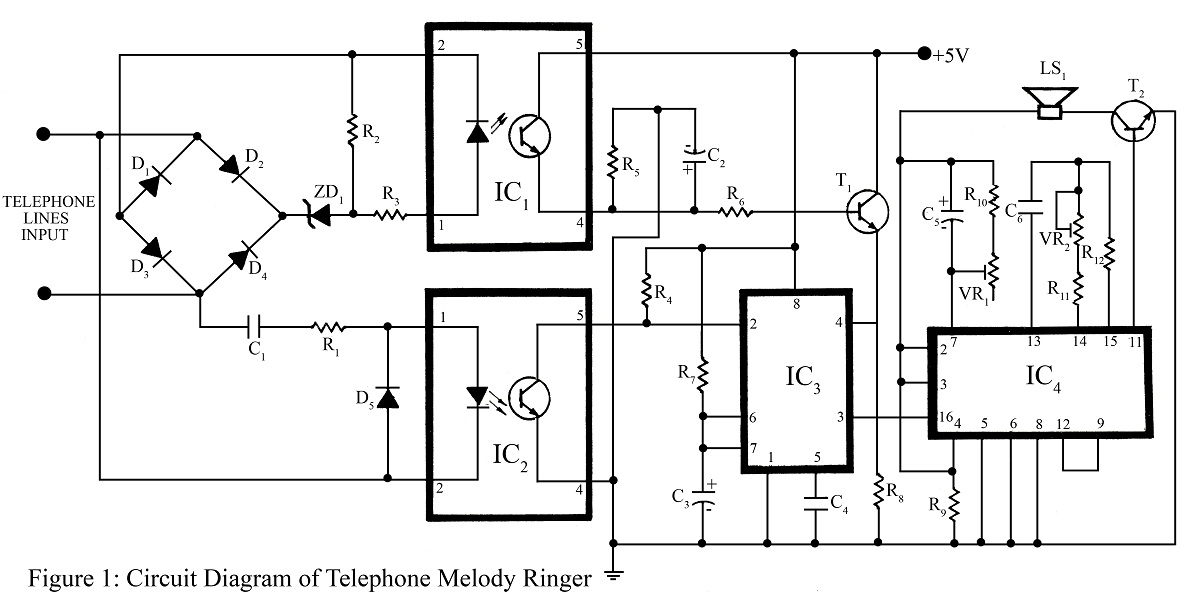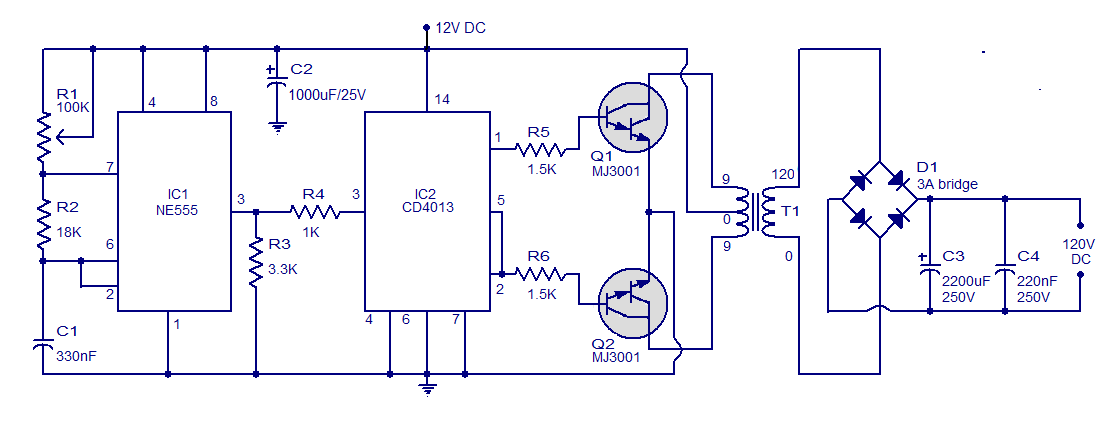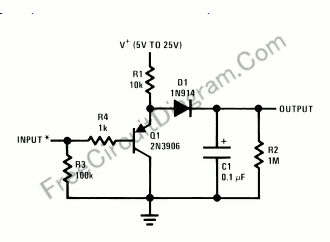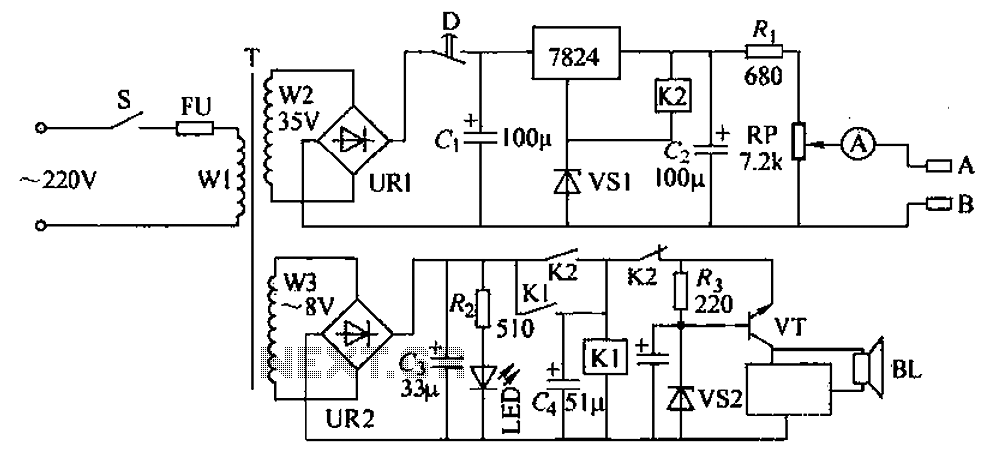
LED digital clock language timekeeping circuit
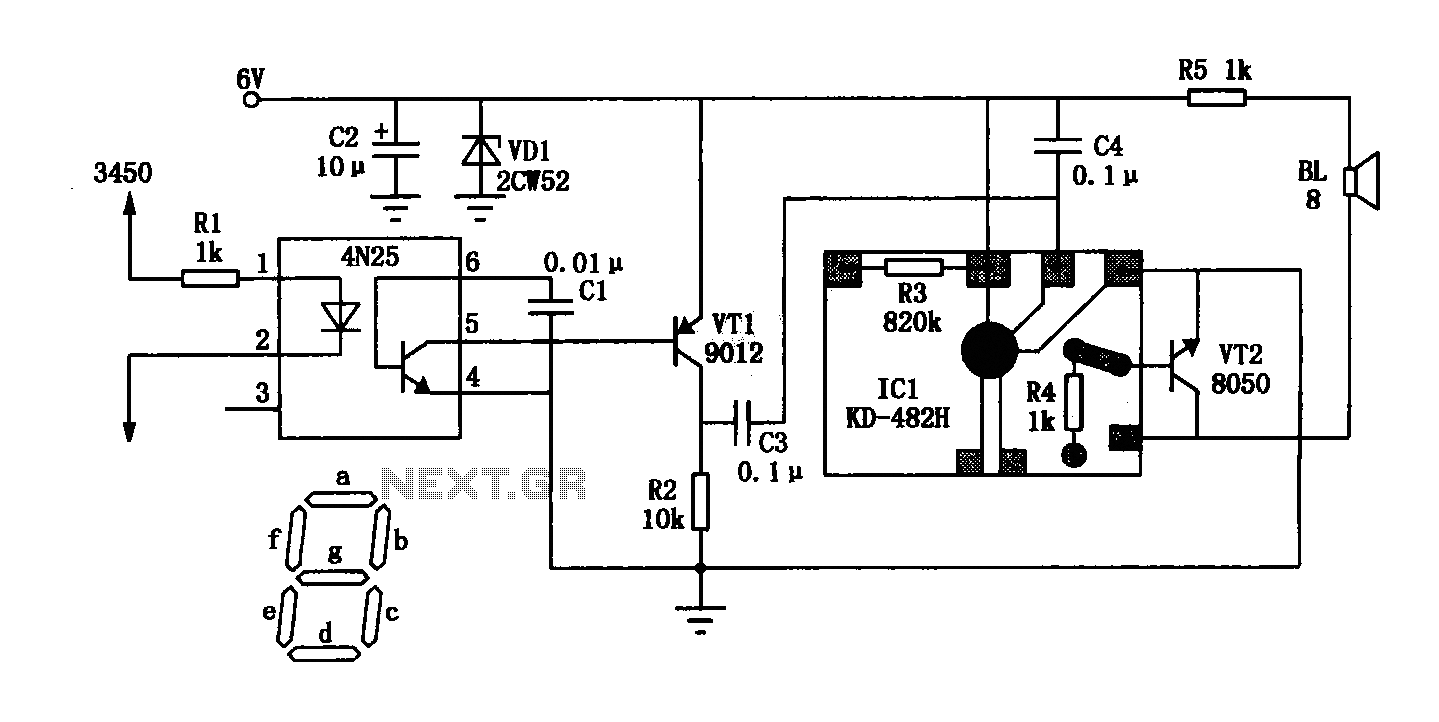
The General Dynamic LED digital clock lacks a timekeeping function, but by adding a simple circuit, it can incorporate this feature. The integrated circuit (IC) includes a programmable mute function, which is inactive from 23:00 to 5:00 to avoid disturbing sleep. The circuit utilizes control signals from the LED digital clock ICs 3450 or 8560, which are common cathode display outputs. For numbers 0 to 4:00, the b segment is at a high level of "1," while it is "0" only for the number 5. This allows for a transition signal from 59 minutes to 00 minutes to be detected. The signal is processed through a current-limiting resistor (Rl) and an optocoupler (4N25) for isolation, which triggers a control signal that is amplified by a transistor (VT1). This amplified signal is then used to activate a speaker (BL) through a Chinese language repeater IC (KD-482H) to produce a chime sound. The use of optocouplers ensures that the normal clock display is not disturbed.
The circuit integrates several components to enhance the functionality of the General Dynamic LED digital clock. The programmable mute function ensures that the clock does not emit sound during designated quiet hours, making it suitable for nighttime use. The core of the timekeeping function is derived from the output of the LED digital clock ICs, specifically the common cathode output, which allows for easy manipulation of the display segments.
When the clock transitions from 59 minutes to 00 minutes, the change in the b segment from a high level to low is detected. This transition is critical as it serves as a trigger for the subsequent processes in the circuit. The current-limiting resistor (Rl) is essential to prevent excessive current from damaging the optocoupler. The 4N25 optocoupler serves to isolate different parts of the circuit, ensuring that the control signals do not interfere with the clock's display functionality.
The amplified control signal, generated by the transistor (VT1), is responsible for driving the speaker (BL). The KD-482H IC plays a pivotal role in modulating the sound output, allowing for a chime to be produced in response to the timekeeping signal. This chime adds an auditory cue for the user, enhancing the usability of the clock.
Overall, the incorporation of this circuit transforms a basic LED digital clock into a functional timekeeping device with sound alerts while maintaining the integrity of the original clock display. The design emphasizes the importance of signal isolation and amplification to ensure reliable operation without compromising the clock's primary function.General Dynamic LED digital clock have no timekeeping function, just add here a simple circuit it can bring the whole point timekeeping function. IC itself has used programmable mute function, from 23:00 to 5:00 is not of time, it will not affect normal sleep. Circuit is shown. The whole point timekeeping control signal from the LED digital clock IC 3450 or 8560 feet, the foot is a very common cathode display bit b segment output.
Numbers 0 to 4:00, b segment are high level "1" only in the number 5 that paragraph was to "0." So that when the time from 59 minutes to carry the whole point of 00 minutes, from the potential of the segment can be picked up by a 0 to 1 transition of the signal. This signal by the current-limiting resistor Rl, 4N25 optocoupler isolation coupling, trigger control signal generating transistor VT1 amplified by C3 added ICl Chinese language repeater IC KD-482H trigger pole speaker BL issue can chime sound.
Using optocouplers transmit signals in order not to affect the normal display clock stroke;
The circuit integrates several components to enhance the functionality of the General Dynamic LED digital clock. The programmable mute function ensures that the clock does not emit sound during designated quiet hours, making it suitable for nighttime use. The core of the timekeeping function is derived from the output of the LED digital clock ICs, specifically the common cathode output, which allows for easy manipulation of the display segments.
When the clock transitions from 59 minutes to 00 minutes, the change in the b segment from a high level to low is detected. This transition is critical as it serves as a trigger for the subsequent processes in the circuit. The current-limiting resistor (Rl) is essential to prevent excessive current from damaging the optocoupler. The 4N25 optocoupler serves to isolate different parts of the circuit, ensuring that the control signals do not interfere with the clock's display functionality.
The amplified control signal, generated by the transistor (VT1), is responsible for driving the speaker (BL). The KD-482H IC plays a pivotal role in modulating the sound output, allowing for a chime to be produced in response to the timekeeping signal. This chime adds an auditory cue for the user, enhancing the usability of the clock.
Overall, the incorporation of this circuit transforms a basic LED digital clock into a functional timekeeping device with sound alerts while maintaining the integrity of the original clock display. The design emphasizes the importance of signal isolation and amplification to ensure reliable operation without compromising the clock's primary function.General Dynamic LED digital clock have no timekeeping function, just add here a simple circuit it can bring the whole point timekeeping function. IC itself has used programmable mute function, from 23:00 to 5:00 is not of time, it will not affect normal sleep. Circuit is shown. The whole point timekeeping control signal from the LED digital clock IC 3450 or 8560 feet, the foot is a very common cathode display bit b segment output.
Numbers 0 to 4:00, b segment are high level "1" only in the number 5 that paragraph was to "0." So that when the time from 59 minutes to carry the whole point of 00 minutes, from the potential of the segment can be picked up by a 0 to 1 transition of the signal. This signal by the current-limiting resistor Rl, 4N25 optocoupler isolation coupling, trigger control signal generating transistor VT1 amplified by C3 added ICl Chinese language repeater IC KD-482H trigger pole speaker BL issue can chime sound.
Using optocouplers transmit signals in order not to affect the normal display clock stroke;
